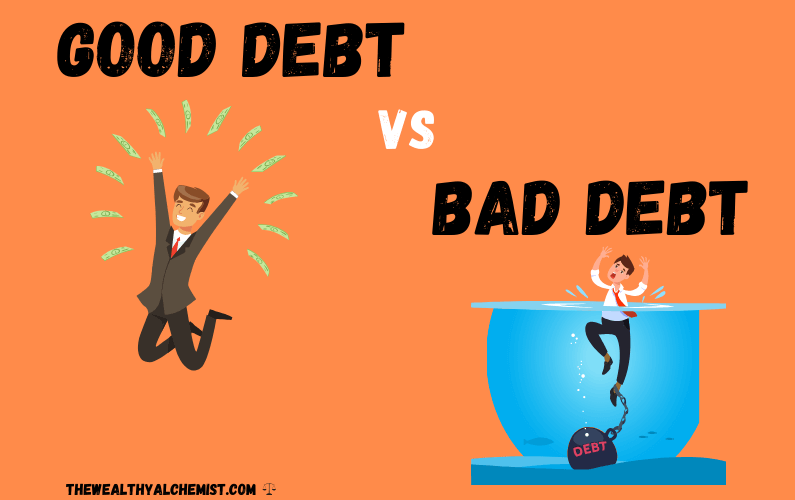
I’ve been seeing the term good debt vs bad debt for a while now.
But I never thought much about it though, because as far as I was always concerned, all debt is bad debt…right?
Follow my logic for a minute…
Debt = Decreased future income = ![]() .
.
That’s obviously bad, right??
Right!
Well, it turns out that my accounting nerd of a husband disagrees with me on this. Typical…
But not only that, a lot of personal finance writers feel that some debt can actually be a good thing as well!
So, after hearing about this supposedly “good debt” multiple times, I decided to look into the topic myself.
This is what I found out…
Good debt is (spoiler alert!) a debt that increases your net worth and/or future incoming cash flow.
Bad debt, however, decreases your net worth and/or future cash flow.
Uh oh…so, does that mean you’re screwed if you have all bad debt? And are you golden if you have only the good variety?
Those are all excellent questions!
I believe that if we can answer those basic questions, we’ll have a good handle on the issue of good debt vs. bad debt.
And more importantly, we’ll know why it’s good or bad (which is, honestly, where I’m struggling the most to understand).
Debt Neutrality
Let’s first talk about debt in neutral terms.
A debt is something owed by someone to someone else.
We typically go into debt because we want to buy something, and we don’t have all the money on us at the time.
But, the thing is, when you take out a loan, you’re not just borrowing from some fat cat banker (picture the Monopoly man).
To me, this always seemed like a terrible situation, so I had always taken it for granted that all debt was bad.
But it turns out that this is only one half of the story. And half of the story alone can’t tell us whether the debt you’re incurring now is good or bad.
To get a better understanding of how to differentiate good debt vs. bad debt, I looked at a few of the most commonly cited examples of each type of debt.
Related Post: Adios Debt. 10 Strategies to Get Rid of Debt.
Examples of Good Debt
Education:
Maybe you’ve heard it said that education is an investment.
Even if you haven’t heard those exact words, I’m sure the idea resonates with you as a popular notion in our culture.
Borrowing money for your higher education should help you get a higher paying job and increase your future cash flows.
In fact, the data shows that college graduates tend to earn more than non-college graduates, as we can see here and here.
Mortgages:
Homeownership is still a fundamental part of the American Dream.
But, it’s a rare person that can drop several stacks of Benjamins on their realtor’s table and pay for a house outright.
So, taking out a mortgage is the most frequent option that Americans take when buying a house.
And even after the 2008 crisis, mortgages are generally still considered to be good debt because property always has value, and that value tends to increase over time.
Not to mention the tax benefits of homeownership.
Business Investment:

We’ve all heard that “it takes money to make money.”
And this seems to have some truth in it based on the number of loans that small businesses take to keep their doors open.
But while businesses that take out loans can still fail and put their owners in dire straits, business loans are generally considered to be good debt.
This is because business loans create an opportunity for future profits and increased cash flow.
So as we can see, the thread connecting all of those types of good debt is that they hold the promise of future increases in cash flow or net worth.
Examples of Bad Debt
Car Loans
Forty-four percent of American adults have an outstanding car loan.
And while a car may be necessary for many of us to drive around and get to work, a car is still a depreciating asset.
In fact, according to CARFAX, cars could lose more than 10% of their value during the first month after you drive it off the lot.
And the value just keeps dropping from there…
So, basically, when you take out a car loan, you’re holding the exact opposite of an investment.
You’re making monthly payments for something that’s rapidly losing value instead of collecting dividends on something that’s increasing in value.
Talk about a double whammy.
No wonder car loans are considered a bad debt.
In addition to this, you should take into account the cost of gas, maintenance, and repairs.
And depending on which make and model you get, a simple appointment with the mechanic can make your wallet cry instantly…
Credit Cards
Credit cards are considered one of the worst types of bad debt out there for a good reason.
The interest rates on credit cards are much higher than the rates on consumer loans. This means that your outgoing future cash flow can also be much higher.
On top of that, the types of items most of us buy with credit cards aren’t going to increase our net worth.
So we’re basically decreasing our future cash flow without buying any appreciable assets.
Related Post: Adios Debt. 10 strategies to get rid of debt.
Consumable Goods
Furniture, wedding rings, mattresses…
These are all examples of consumable goods that we can buy on credit. And they follow the same basic bad debt formula as car loans and credit cards.
We acquire something that doesn’t increase our net worth today and promise to pay for it tomorrow with interest.
Soooo, am I screwed?
After going through examples of good debt vs. bad debt, you may have noticed that the vast majority of the debts you have would technically qualify as bad debt.
Even if you have some that qualify as good, they may not feel particularly good to you.
I know how you feel.
Trust me…
So, it’s only natural to wonder…am I screwed?
Honestly, I have no idea…but there is something that can help you figure it out; it’s called the debt to income ratio (DTI).
Your DTI is your total monthly debt obligations divided by your total monthly income.
Or said another way, it’s the percentage of your monthly income that’s spent on paying your debts.
And as you may suspect, the lower this percentage, the better.
So, you could have all bad debt but a DTI of only 5%. Who’d feel screwed in that scenario?
Not me!
On the other hand, you could have all good debt but a DTI of 75%. If that’s the case, there’d be no question about how screwed you are.
At the end of the day, it’s all about how financially comfortable you are with your level of debt regardless of whether it’s good debt or bad.
Can I Switch?
After talking about DTI, it may not seem necessary to talk about switching between good and bad debt.
I mean, if your DTI is 5% then you probably don’t care whether your debts are technically “good” or “bad.” Right?
Right!
But if your DTI is uncomfortably high or you just like the idea of increasing your monthly income, then you may be interested in this question.
Or if you happen to have good debt, then you may want to prevent it from becoming bad debt. So this question may apply to you as well!
But is it even possible to switch from good debt to bad debt or vice versa?
Let’s tackle the switch from good debt to bad debt first.
Good to Bad
Student loans are usually considered good debt because they come with the promise of higher future income.
But we all know someone who’s dropped out of school because it wasn’t right for them. And there are many cases where people graduate but never end up using their major.
In those cases, student loans aren’t related to increased cash flow. They’re just a dark cloud hanging over your head.
So, something that many considered initially to be a good debt actually turned into bad debt.
The same is often true for business loans.
I mean, businesses fail all the time while owing money to lenders.
It’s happened so often that it’s practically a movie genre!
So, a business loan that initially promised increased profits can become a bad debt after the opportunity to earn profits disappeared.
Need I go on?
It seems pretty clear just from those two examples that good debts can go sour as soon as the promise of future cash flows is broken.
But what about your mortgage? Could a mortgage ever be bad debt?
I believe so. But I believe the souring of a mortgage (which increases your net worth) is a bit different from the souring of a student loan (which doesn’t increase your net worth).
When you take on a mortgage, you’re going into debt, but at the same time, you’re getting an asset that should increase in value.
But what happens if your home starts to decrease in value? And what happens if you decide to move before its value increases again?
You’d end up losing money, which would just decrease your net worth.
So, you see, it’s a bit more complicated, but I believe mortgages, too can go bad.
Bad to Good
So what about taking a bad debt and turning it into something beautiful?
I believe this is possible, as well.
As we mentioned before, bad debt does not increase your cash flow or net worth.
But just because you bought something that didn’t do either of those things doesn’t mean you can’t repurpose it!
Imagine you bought a car and that it lost value as soon as you drove it off the lot. Well, that’s not good, but what if you’re driving for Uber or Lyft?
Well, that’s a horse of a different color, isn’t it? That car is now making it rain cold hard cash.
And by any definition, a car that makes it rain cash is a good investment!
How about that spare bed you bought on credit? Bad debt? Yeah…but put that sucker to good use with Airbnb, and now it’s good debt.
Related Post: Adios Debt. 10 strategies to get rid of debt.
Good Debt vs Bad Debt – Final Thoughts
In the beginning, I told you that I had a hard time with the concept of good debt vs. bad debt.
After researching and reading on the subject, I have to tell you that I now understand the distinction better.
I understand it, but I still wouldn’t recommend that anyone gets into “good debt” because it’s “good.”
After all, a good debt that eats up 75% of your income isn’t good.
The one thing I can take away from this is that good debt, and bad debt isn’t about what the financial experts say. It’s about our own comfort level and intentions.
If we’re losing sleep over the amount we owe or are struggling to make payments, that’s a problem.
By the same token, if we buy a car that loses 10% of its value in 10 seconds, but we have a plan to make a better future with that car…well, that’s ok too.
In the end, it’s about doing what’s right for you.
What do you think about good debt vs bad debt?
Cheers!

Idalmis
Latest posts by Idalmis (see all)
- Why Is Budgeting Important? 12 Best Reasons to Start Budgeting Today! - October 6, 2020
- How to be Frugal With Groceries. Must Try Tips! - September 15, 2020
- Is Skillshare Worth It? Best 2020 Review - August 31, 2020




